Innovation and Commercialisation Report for YOYO Drinks - NSAB588B8SAT
VerifiedAdded on 2022/11/13
|12
|3682
|261
Report
AI Summary
This report provides a comprehensive analysis of innovation and commercialization strategies, focusing on a case study of YOYO Drinks. It begins with an executive summary outlining the key topics covered, including various innovation types such as radical, architectural, and disruptive innovation, and the distinctions between invention and innovation. The report explores the importance of innovation for firms, particularly YOYO Drinks, and discusses the implementation of incremental and disruptive innovation. It delves into the 4Ps of innovation (paradigm, product, process, and position) and their role in supporting capability and management. Furthermore, it examines the use of New Product Development (NPD) processes, innovation funnels, and frugal innovation, offering recommendations for YOYO Drinks to improve its market position. The report concludes with a summary of the findings and recommendations, supported by a reference list. The report also contains an introduction, findings and analysis, and a conclusion.
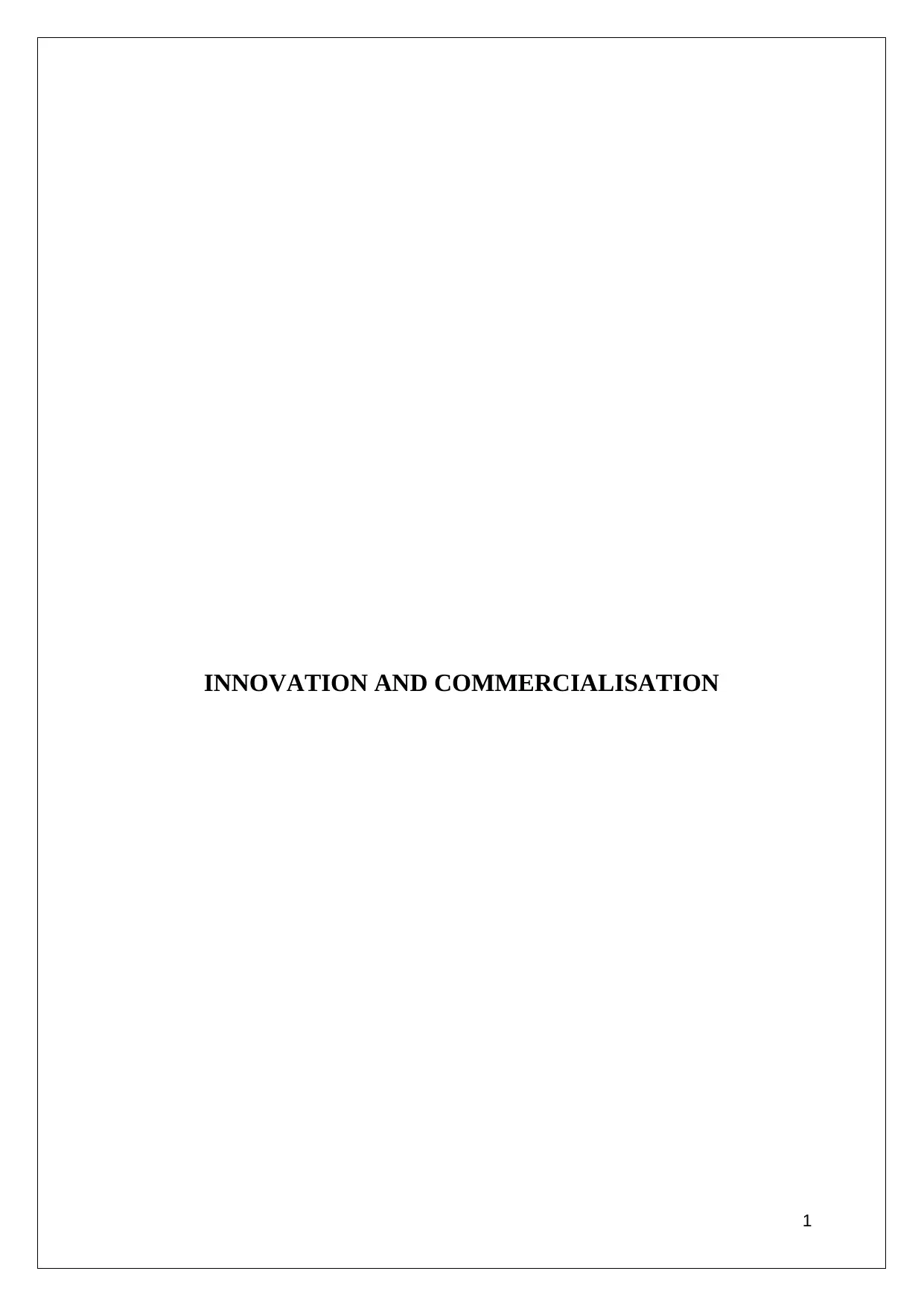
INNOVATION AND COMMERCIALISATION
1
1
Paraphrase This Document
Need a fresh take? Get an instant paraphrase of this document with our AI Paraphraser
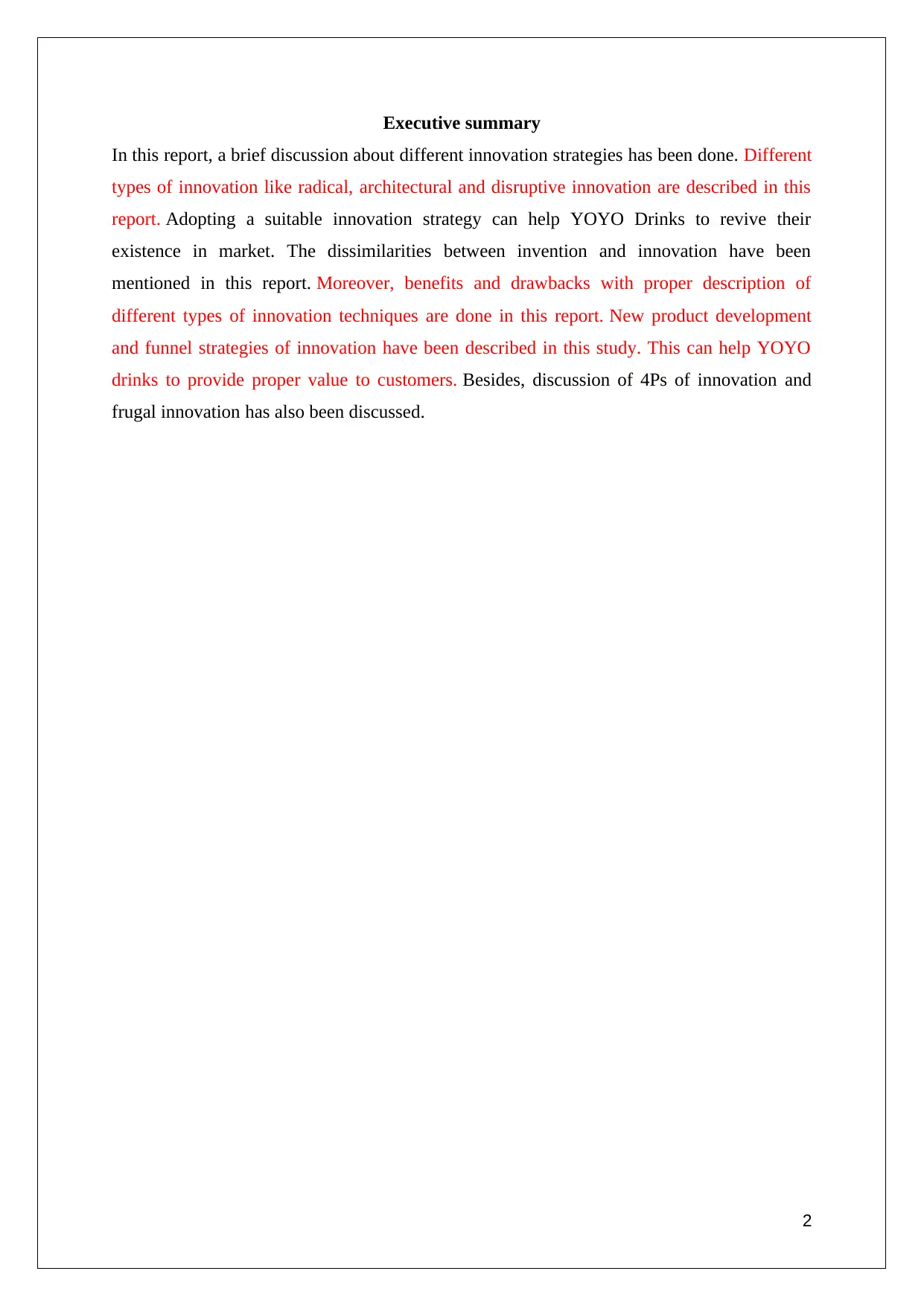
Executive summary
In this report, a brief discussion about different innovation strategies has been done. Different
types of innovation like radical, architectural and disruptive innovation are described in this
report. Adopting a suitable innovation strategy can help YOYO Drinks to revive their
existence in market. The dissimilarities between invention and innovation have been
mentioned in this report. Moreover, benefits and drawbacks with proper description of
different types of innovation techniques are done in this report. New product development
and funnel strategies of innovation have been described in this study. This can help YOYO
drinks to provide proper value to customers. Besides, discussion of 4Ps of innovation and
frugal innovation has also been discussed.
2
In this report, a brief discussion about different innovation strategies has been done. Different
types of innovation like radical, architectural and disruptive innovation are described in this
report. Adopting a suitable innovation strategy can help YOYO Drinks to revive their
existence in market. The dissimilarities between invention and innovation have been
mentioned in this report. Moreover, benefits and drawbacks with proper description of
different types of innovation techniques are done in this report. New product development
and funnel strategies of innovation have been described in this study. This can help YOYO
drinks to provide proper value to customers. Besides, discussion of 4Ps of innovation and
frugal innovation has also been discussed.
2
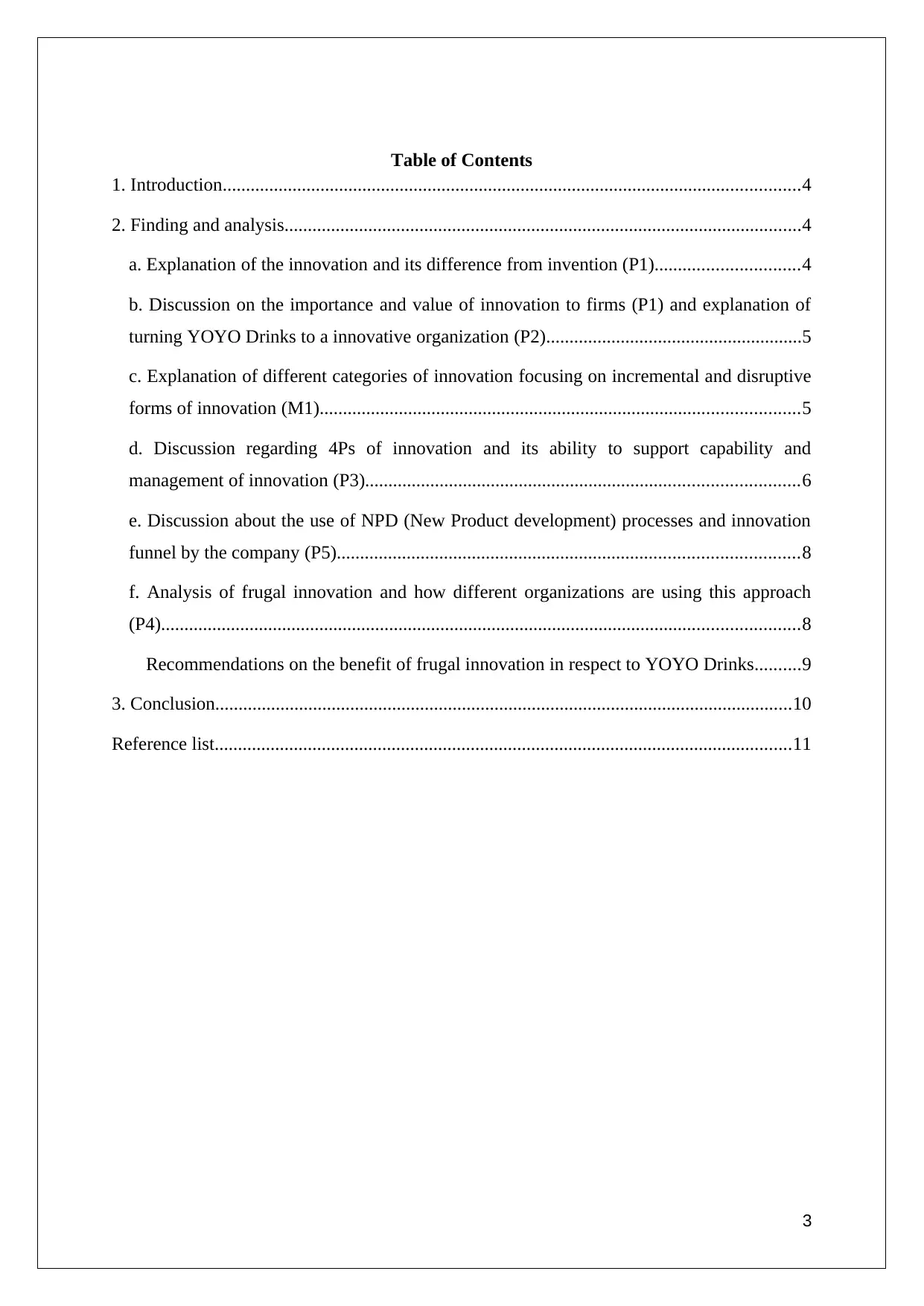
Table of Contents
1. Introduction............................................................................................................................4
2. Finding and analysis...............................................................................................................4
a. Explanation of the innovation and its difference from invention (P1)...............................4
b. Discussion on the importance and value of innovation to firms (P1) and explanation of
turning YOYO Drinks to a innovative organization (P2).......................................................5
c. Explanation of different categories of innovation focusing on incremental and disruptive
forms of innovation (M1).......................................................................................................5
d. Discussion regarding 4Ps of innovation and its ability to support capability and
management of innovation (P3).............................................................................................6
e. Discussion about the use of NPD (New Product development) processes and innovation
funnel by the company (P5)...................................................................................................8
f. Analysis of frugal innovation and how different organizations are using this approach
(P4).........................................................................................................................................8
Recommendations on the benefit of frugal innovation in respect to YOYO Drinks..........9
3. Conclusion............................................................................................................................10
Reference list............................................................................................................................11
3
1. Introduction............................................................................................................................4
2. Finding and analysis...............................................................................................................4
a. Explanation of the innovation and its difference from invention (P1)...............................4
b. Discussion on the importance and value of innovation to firms (P1) and explanation of
turning YOYO Drinks to a innovative organization (P2).......................................................5
c. Explanation of different categories of innovation focusing on incremental and disruptive
forms of innovation (M1).......................................................................................................5
d. Discussion regarding 4Ps of innovation and its ability to support capability and
management of innovation (P3).............................................................................................6
e. Discussion about the use of NPD (New Product development) processes and innovation
funnel by the company (P5)...................................................................................................8
f. Analysis of frugal innovation and how different organizations are using this approach
(P4).........................................................................................................................................8
Recommendations on the benefit of frugal innovation in respect to YOYO Drinks..........9
3. Conclusion............................................................................................................................10
Reference list............................................................................................................................11
3
⊘ This is a preview!⊘
Do you want full access?
Subscribe today to unlock all pages.

Trusted by 1+ million students worldwide
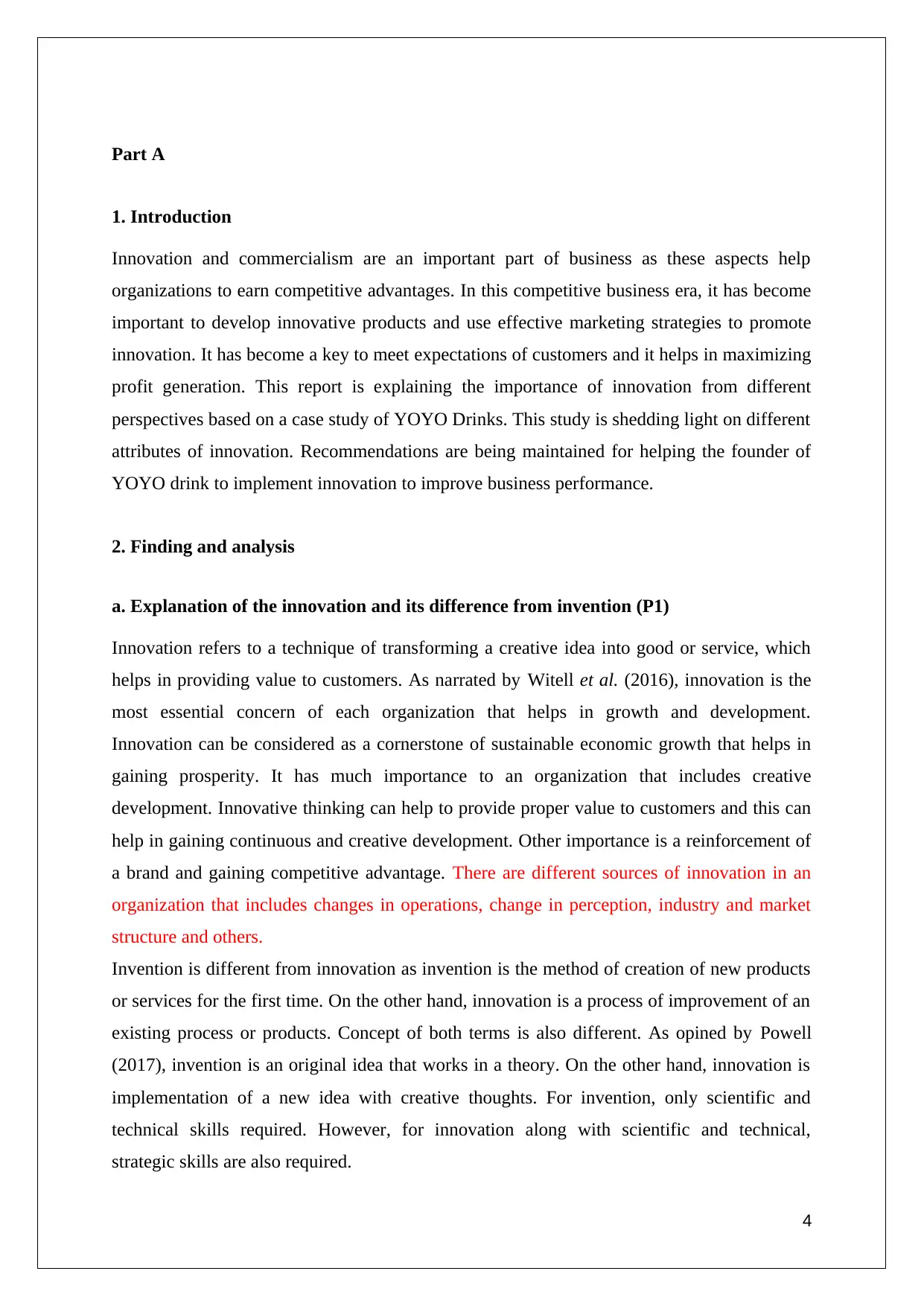
Part A
1. Introduction
Innovation and commercialism are an important part of business as these aspects help
organizations to earn competitive advantages. In this competitive business era, it has become
important to develop innovative products and use effective marketing strategies to promote
innovation. It has become a key to meet expectations of customers and it helps in maximizing
profit generation. This report is explaining the importance of innovation from different
perspectives based on a case study of YOYO Drinks. This study is shedding light on different
attributes of innovation. Recommendations are being maintained for helping the founder of
YOYO drink to implement innovation to improve business performance.
2. Finding and analysis
a. Explanation of the innovation and its difference from invention (P1)
Innovation refers to a technique of transforming a creative idea into good or service, which
helps in providing value to customers. As narrated by Witell et al. (2016), innovation is the
most essential concern of each organization that helps in growth and development.
Innovation can be considered as a cornerstone of sustainable economic growth that helps in
gaining prosperity. It has much importance to an organization that includes creative
development. Innovative thinking can help to provide proper value to customers and this can
help in gaining continuous and creative development. Other importance is a reinforcement of
a brand and gaining competitive advantage. There are different sources of innovation in an
organization that includes changes in operations, change in perception, industry and market
structure and others.
Invention is different from innovation as invention is the method of creation of new products
or services for the first time. On the other hand, innovation is a process of improvement of an
existing process or products. Concept of both terms is also different. As opined by Powell
(2017), invention is an original idea that works in a theory. On the other hand, innovation is
implementation of a new idea with creative thoughts. For invention, only scientific and
technical skills required. However, for innovation along with scientific and technical,
strategic skills are also required.
4
1. Introduction
Innovation and commercialism are an important part of business as these aspects help
organizations to earn competitive advantages. In this competitive business era, it has become
important to develop innovative products and use effective marketing strategies to promote
innovation. It has become a key to meet expectations of customers and it helps in maximizing
profit generation. This report is explaining the importance of innovation from different
perspectives based on a case study of YOYO Drinks. This study is shedding light on different
attributes of innovation. Recommendations are being maintained for helping the founder of
YOYO drink to implement innovation to improve business performance.
2. Finding and analysis
a. Explanation of the innovation and its difference from invention (P1)
Innovation refers to a technique of transforming a creative idea into good or service, which
helps in providing value to customers. As narrated by Witell et al. (2016), innovation is the
most essential concern of each organization that helps in growth and development.
Innovation can be considered as a cornerstone of sustainable economic growth that helps in
gaining prosperity. It has much importance to an organization that includes creative
development. Innovative thinking can help to provide proper value to customers and this can
help in gaining continuous and creative development. Other importance is a reinforcement of
a brand and gaining competitive advantage. There are different sources of innovation in an
organization that includes changes in operations, change in perception, industry and market
structure and others.
Invention is different from innovation as invention is the method of creation of new products
or services for the first time. On the other hand, innovation is a process of improvement of an
existing process or products. Concept of both terms is also different. As opined by Powell
(2017), invention is an original idea that works in a theory. On the other hand, innovation is
implementation of a new idea with creative thoughts. For invention, only scientific and
technical skills required. However, for innovation along with scientific and technical,
strategic skills are also required.
4
Paraphrase This Document
Need a fresh take? Get an instant paraphrase of this document with our AI Paraphraser
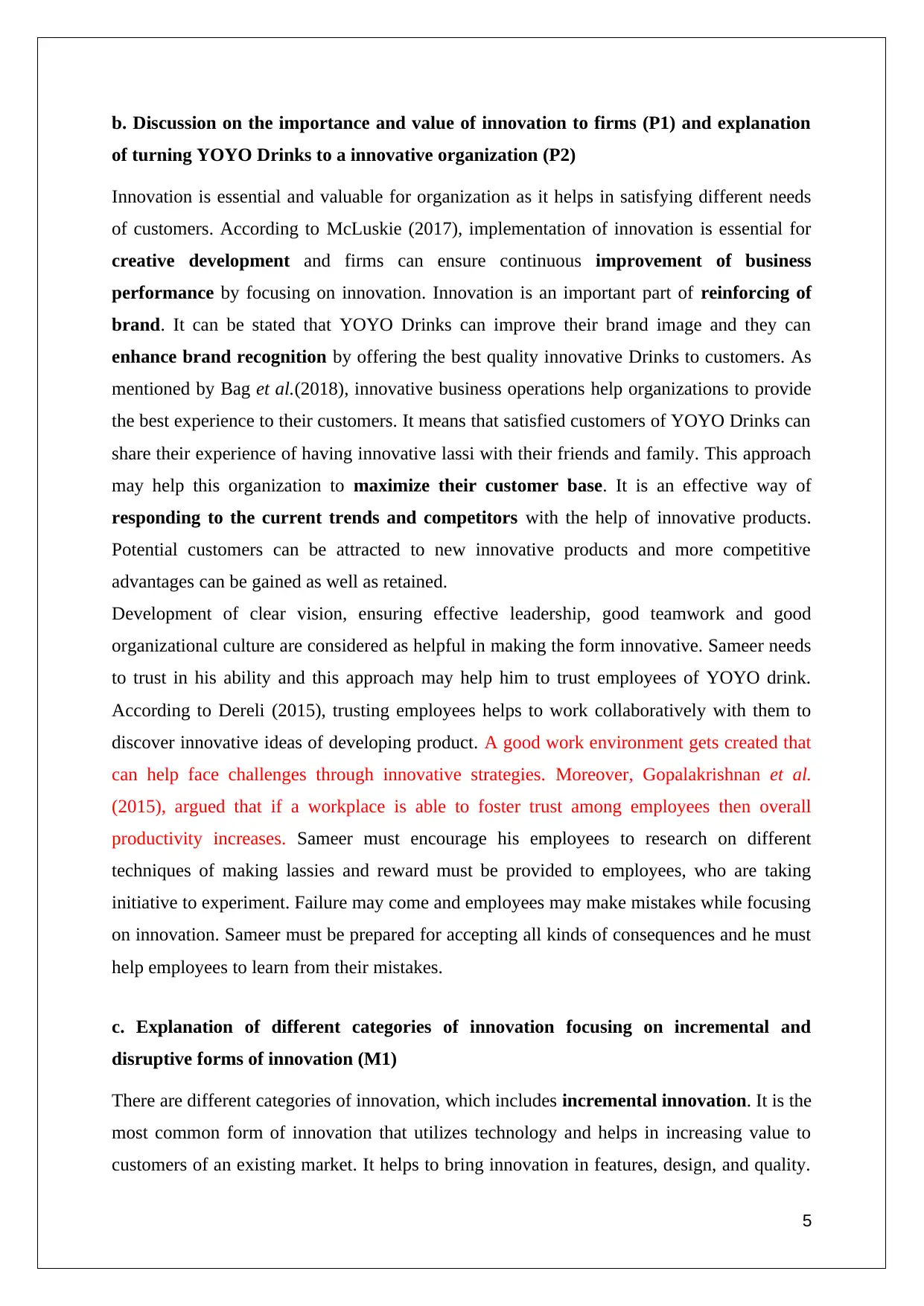
b. Discussion on the importance and value of innovation to firms (P1) and explanation
of turning YOYO Drinks to a innovative organization (P2)
Innovation is essential and valuable for organization as it helps in satisfying different needs
of customers. According to McLuskie (2017), implementation of innovation is essential for
creative development and firms can ensure continuous improvement of business
performance by focusing on innovation. Innovation is an important part of reinforcing of
brand. It can be stated that YOYO Drinks can improve their brand image and they can
enhance brand recognition by offering the best quality innovative Drinks to customers. As
mentioned by Bag et al.(2018), innovative business operations help organizations to provide
the best experience to their customers. It means that satisfied customers of YOYO Drinks can
share their experience of having innovative lassi with their friends and family. This approach
may help this organization to maximize their customer base. It is an effective way of
responding to the current trends and competitors with the help of innovative products.
Potential customers can be attracted to new innovative products and more competitive
advantages can be gained as well as retained.
Development of clear vision, ensuring effective leadership, good teamwork and good
organizational culture are considered as helpful in making the form innovative. Sameer needs
to trust in his ability and this approach may help him to trust employees of YOYO drink.
According to Dereli (2015), trusting employees helps to work collaboratively with them to
discover innovative ideas of developing product. A good work environment gets created that
can help face challenges through innovative strategies. Moreover, Gopalakrishnan et al.
(2015), argued that if a workplace is able to foster trust among employees then overall
productivity increases. Sameer must encourage his employees to research on different
techniques of making lassies and reward must be provided to employees, who are taking
initiative to experiment. Failure may come and employees may make mistakes while focusing
on innovation. Sameer must be prepared for accepting all kinds of consequences and he must
help employees to learn from their mistakes.
c. Explanation of different categories of innovation focusing on incremental and
disruptive forms of innovation (M1)
There are different categories of innovation, which includes incremental innovation. It is the
most common form of innovation that utilizes technology and helps in increasing value to
customers of an existing market. It helps to bring innovation in features, design, and quality.
5
of turning YOYO Drinks to a innovative organization (P2)
Innovation is essential and valuable for organization as it helps in satisfying different needs
of customers. According to McLuskie (2017), implementation of innovation is essential for
creative development and firms can ensure continuous improvement of business
performance by focusing on innovation. Innovation is an important part of reinforcing of
brand. It can be stated that YOYO Drinks can improve their brand image and they can
enhance brand recognition by offering the best quality innovative Drinks to customers. As
mentioned by Bag et al.(2018), innovative business operations help organizations to provide
the best experience to their customers. It means that satisfied customers of YOYO Drinks can
share their experience of having innovative lassi with their friends and family. This approach
may help this organization to maximize their customer base. It is an effective way of
responding to the current trends and competitors with the help of innovative products.
Potential customers can be attracted to new innovative products and more competitive
advantages can be gained as well as retained.
Development of clear vision, ensuring effective leadership, good teamwork and good
organizational culture are considered as helpful in making the form innovative. Sameer needs
to trust in his ability and this approach may help him to trust employees of YOYO drink.
According to Dereli (2015), trusting employees helps to work collaboratively with them to
discover innovative ideas of developing product. A good work environment gets created that
can help face challenges through innovative strategies. Moreover, Gopalakrishnan et al.
(2015), argued that if a workplace is able to foster trust among employees then overall
productivity increases. Sameer must encourage his employees to research on different
techniques of making lassies and reward must be provided to employees, who are taking
initiative to experiment. Failure may come and employees may make mistakes while focusing
on innovation. Sameer must be prepared for accepting all kinds of consequences and he must
help employees to learn from their mistakes.
c. Explanation of different categories of innovation focusing on incremental and
disruptive forms of innovation (M1)
There are different categories of innovation, which includes incremental innovation. It is the
most common form of innovation that utilizes technology and helps in increasing value to
customers of an existing market. It helps to bring innovation in features, design, and quality.
5
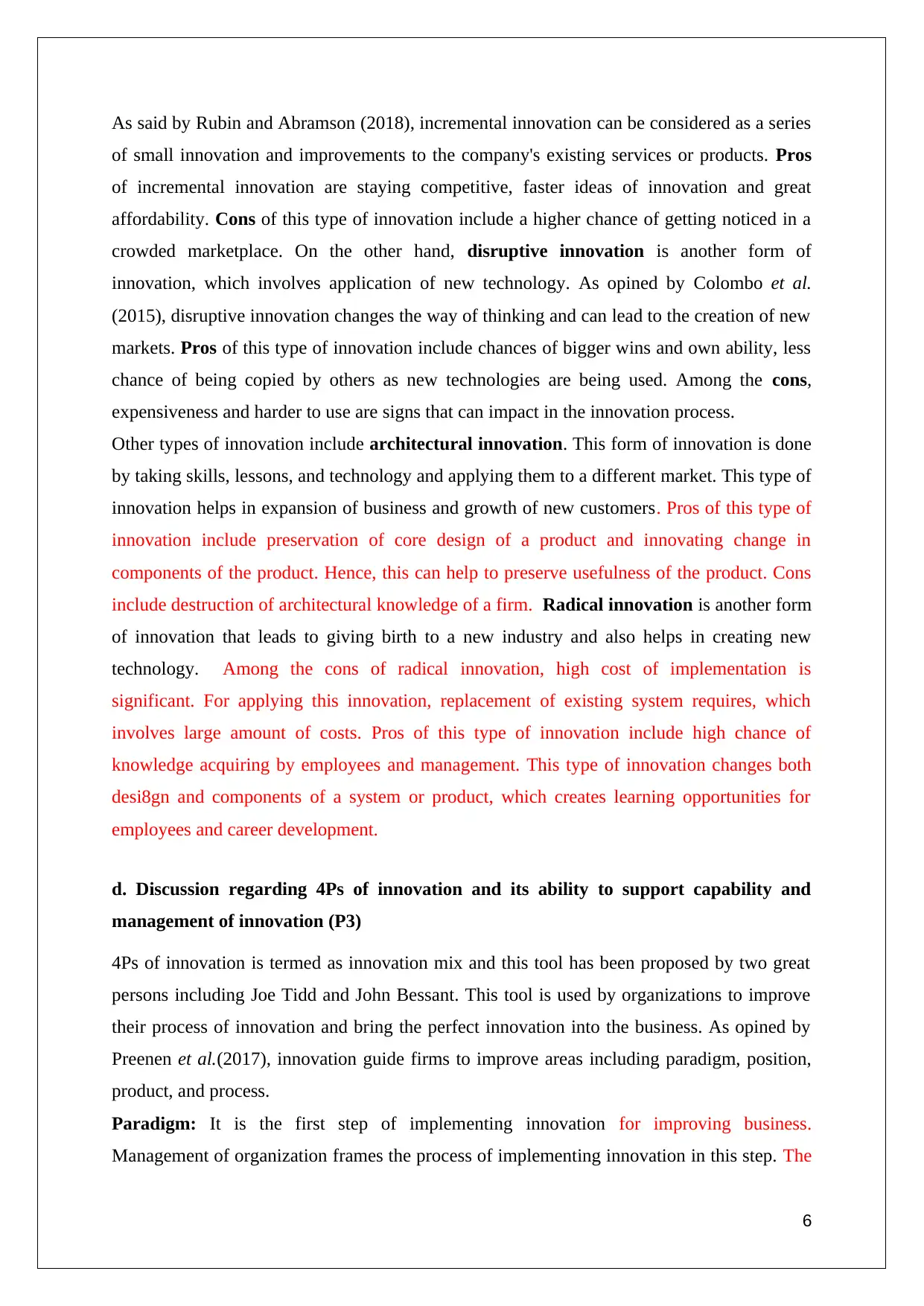
As said by Rubin and Abramson (2018), incremental innovation can be considered as a series
of small innovation and improvements to the company's existing services or products. Pros
of incremental innovation are staying competitive, faster ideas of innovation and great
affordability. Cons of this type of innovation include a higher chance of getting noticed in a
crowded marketplace. On the other hand, disruptive innovation is another form of
innovation, which involves application of new technology. As opined by Colombo et al.
(2015), disruptive innovation changes the way of thinking and can lead to the creation of new
markets. Pros of this type of innovation include chances of bigger wins and own ability, less
chance of being copied by others as new technologies are being used. Among the cons,
expensiveness and harder to use are signs that can impact in the innovation process.
Other types of innovation include architectural innovation. This form of innovation is done
by taking skills, lessons, and technology and applying them to a different market. This type of
innovation helps in expansion of business and growth of new customers. Pros of this type of
innovation include preservation of core design of a product and innovating change in
components of the product. Hence, this can help to preserve usefulness of the product. Cons
include destruction of architectural knowledge of a firm. Radical innovation is another form
of innovation that leads to giving birth to a new industry and also helps in creating new
technology. Among the cons of radical innovation, high cost of implementation is
significant. For applying this innovation, replacement of existing system requires, which
involves large amount of costs. Pros of this type of innovation include high chance of
knowledge acquiring by employees and management. This type of innovation changes both
desi8gn and components of a system or product, which creates learning opportunities for
employees and career development.
d. Discussion regarding 4Ps of innovation and its ability to support capability and
management of innovation (P3)
4Ps of innovation is termed as innovation mix and this tool has been proposed by two great
persons including Joe Tidd and John Bessant. This tool is used by organizations to improve
their process of innovation and bring the perfect innovation into the business. As opined by
Preenen et al.(2017), innovation guide firms to improve areas including paradigm, position,
product, and process.
Paradigm: It is the first step of implementing innovation for improving business.
Management of organization frames the process of implementing innovation in this step. The
6
of small innovation and improvements to the company's existing services or products. Pros
of incremental innovation are staying competitive, faster ideas of innovation and great
affordability. Cons of this type of innovation include a higher chance of getting noticed in a
crowded marketplace. On the other hand, disruptive innovation is another form of
innovation, which involves application of new technology. As opined by Colombo et al.
(2015), disruptive innovation changes the way of thinking and can lead to the creation of new
markets. Pros of this type of innovation include chances of bigger wins and own ability, less
chance of being copied by others as new technologies are being used. Among the cons,
expensiveness and harder to use are signs that can impact in the innovation process.
Other types of innovation include architectural innovation. This form of innovation is done
by taking skills, lessons, and technology and applying them to a different market. This type of
innovation helps in expansion of business and growth of new customers. Pros of this type of
innovation include preservation of core design of a product and innovating change in
components of the product. Hence, this can help to preserve usefulness of the product. Cons
include destruction of architectural knowledge of a firm. Radical innovation is another form
of innovation that leads to giving birth to a new industry and also helps in creating new
technology. Among the cons of radical innovation, high cost of implementation is
significant. For applying this innovation, replacement of existing system requires, which
involves large amount of costs. Pros of this type of innovation include high chance of
knowledge acquiring by employees and management. This type of innovation changes both
desi8gn and components of a system or product, which creates learning opportunities for
employees and career development.
d. Discussion regarding 4Ps of innovation and its ability to support capability and
management of innovation (P3)
4Ps of innovation is termed as innovation mix and this tool has been proposed by two great
persons including Joe Tidd and John Bessant. This tool is used by organizations to improve
their process of innovation and bring the perfect innovation into the business. As opined by
Preenen et al.(2017), innovation guide firms to improve areas including paradigm, position,
product, and process.
Paradigm: It is the first step of implementing innovation for improving business.
Management of organization frames the process of implementing innovation in this step. The
6
⊘ This is a preview!⊘
Do you want full access?
Subscribe today to unlock all pages.

Trusted by 1+ million students worldwide
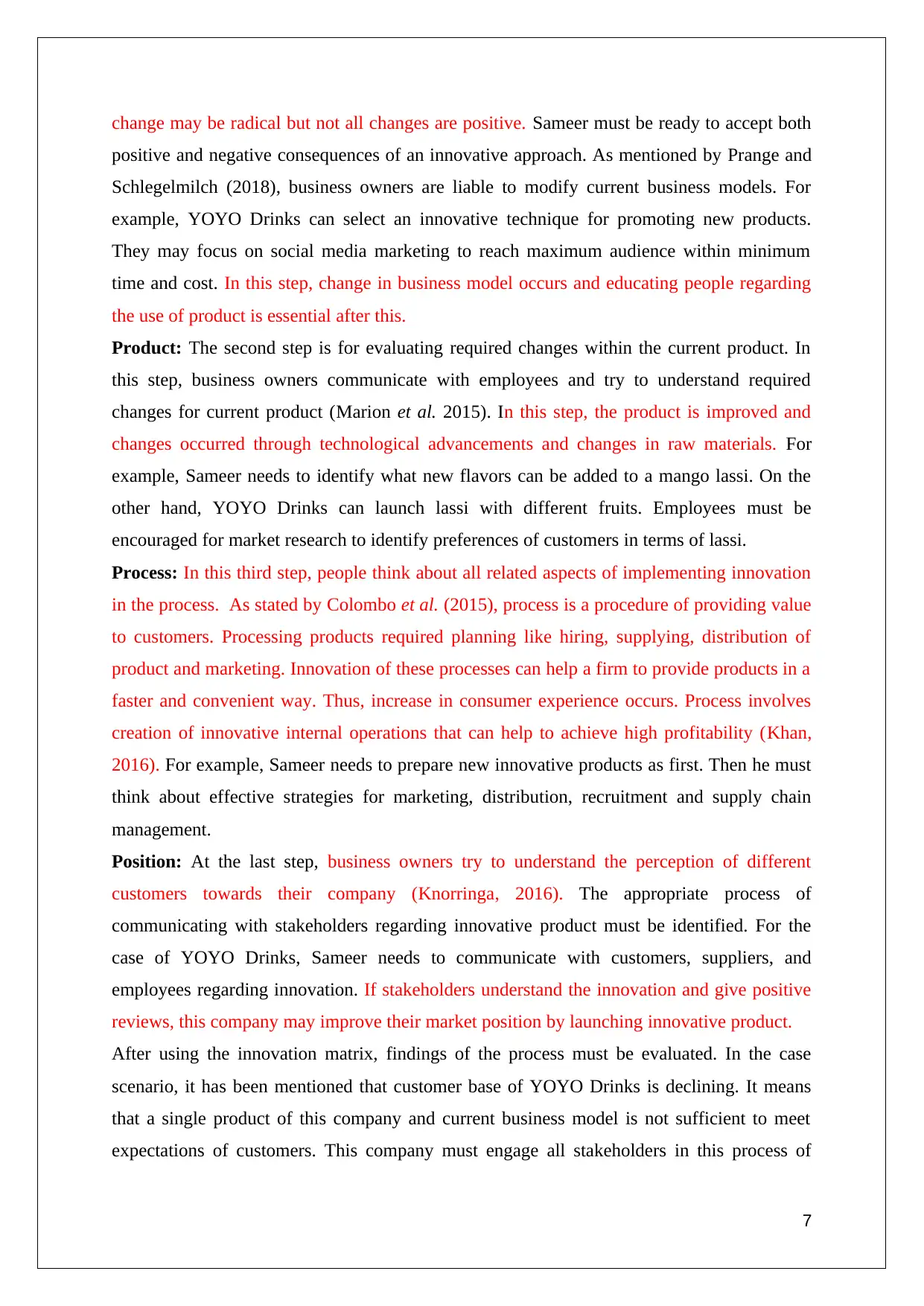
change may be radical but not all changes are positive. Sameer must be ready to accept both
positive and negative consequences of an innovative approach. As mentioned by Prange and
Schlegelmilch (2018), business owners are liable to modify current business models. For
example, YOYO Drinks can select an innovative technique for promoting new products.
They may focus on social media marketing to reach maximum audience within minimum
time and cost. In this step, change in business model occurs and educating people regarding
the use of product is essential after this.
Product: The second step is for evaluating required changes within the current product. In
this step, business owners communicate with employees and try to understand required
changes for current product (Marion et al. 2015). In this step, the product is improved and
changes occurred through technological advancements and changes in raw materials. For
example, Sameer needs to identify what new flavors can be added to a mango lassi. On the
other hand, YOYO Drinks can launch lassi with different fruits. Employees must be
encouraged for market research to identify preferences of customers in terms of lassi.
Process: In this third step, people think about all related aspects of implementing innovation
in the process. As stated by Colombo et al. (2015), process is a procedure of providing value
to customers. Processing products required planning like hiring, supplying, distribution of
product and marketing. Innovation of these processes can help a firm to provide products in a
faster and convenient way. Thus, increase in consumer experience occurs. Process involves
creation of innovative internal operations that can help to achieve high profitability (Khan,
2016). For example, Sameer needs to prepare new innovative products as first. Then he must
think about effective strategies for marketing, distribution, recruitment and supply chain
management.
Position: At the last step, business owners try to understand the perception of different
customers towards their company (Knorringa, 2016). The appropriate process of
communicating with stakeholders regarding innovative product must be identified. For the
case of YOYO Drinks, Sameer needs to communicate with customers, suppliers, and
employees regarding innovation. If stakeholders understand the innovation and give positive
reviews, this company may improve their market position by launching innovative product.
After using the innovation matrix, findings of the process must be evaluated. In the case
scenario, it has been mentioned that customer base of YOYO Drinks is declining. It means
that a single product of this company and current business model is not sufficient to meet
expectations of customers. This company must engage all stakeholders in this process of
7
positive and negative consequences of an innovative approach. As mentioned by Prange and
Schlegelmilch (2018), business owners are liable to modify current business models. For
example, YOYO Drinks can select an innovative technique for promoting new products.
They may focus on social media marketing to reach maximum audience within minimum
time and cost. In this step, change in business model occurs and educating people regarding
the use of product is essential after this.
Product: The second step is for evaluating required changes within the current product. In
this step, business owners communicate with employees and try to understand required
changes for current product (Marion et al. 2015). In this step, the product is improved and
changes occurred through technological advancements and changes in raw materials. For
example, Sameer needs to identify what new flavors can be added to a mango lassi. On the
other hand, YOYO Drinks can launch lassi with different fruits. Employees must be
encouraged for market research to identify preferences of customers in terms of lassi.
Process: In this third step, people think about all related aspects of implementing innovation
in the process. As stated by Colombo et al. (2015), process is a procedure of providing value
to customers. Processing products required planning like hiring, supplying, distribution of
product and marketing. Innovation of these processes can help a firm to provide products in a
faster and convenient way. Thus, increase in consumer experience occurs. Process involves
creation of innovative internal operations that can help to achieve high profitability (Khan,
2016). For example, Sameer needs to prepare new innovative products as first. Then he must
think about effective strategies for marketing, distribution, recruitment and supply chain
management.
Position: At the last step, business owners try to understand the perception of different
customers towards their company (Knorringa, 2016). The appropriate process of
communicating with stakeholders regarding innovative product must be identified. For the
case of YOYO Drinks, Sameer needs to communicate with customers, suppliers, and
employees regarding innovation. If stakeholders understand the innovation and give positive
reviews, this company may improve their market position by launching innovative product.
After using the innovation matrix, findings of the process must be evaluated. In the case
scenario, it has been mentioned that customer base of YOYO Drinks is declining. It means
that a single product of this company and current business model is not sufficient to meet
expectations of customers. This company must engage all stakeholders in this process of
7
Paraphrase This Document
Need a fresh take? Get an instant paraphrase of this document with our AI Paraphraser
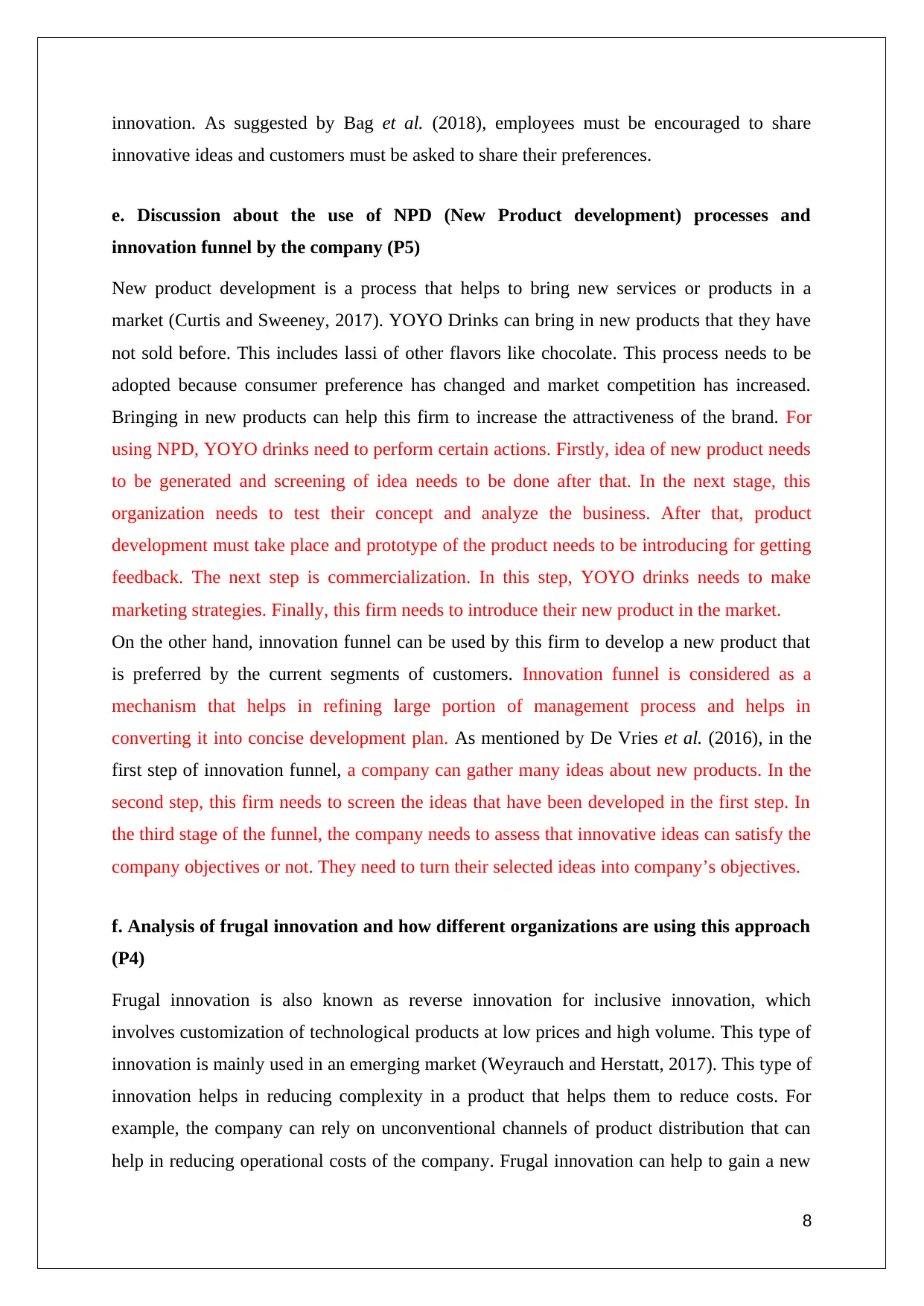
innovation. As suggested by Bag et al. (2018), employees must be encouraged to share
innovative ideas and customers must be asked to share their preferences.
e. Discussion about the use of NPD (New Product development) processes and
innovation funnel by the company (P5)
New product development is a process that helps to bring new services or products in a
market (Curtis and Sweeney, 2017). YOYO Drinks can bring in new products that they have
not sold before. This includes lassi of other flavors like chocolate. This process needs to be
adopted because consumer preference has changed and market competition has increased.
Bringing in new products can help this firm to increase the attractiveness of the brand. For
using NPD, YOYO drinks need to perform certain actions. Firstly, idea of new product needs
to be generated and screening of idea needs to be done after that. In the next stage, this
organization needs to test their concept and analyze the business. After that, product
development must take place and prototype of the product needs to be introducing for getting
feedback. The next step is commercialization. In this step, YOYO drinks needs to make
marketing strategies. Finally, this firm needs to introduce their new product in the market.
On the other hand, innovation funnel can be used by this firm to develop a new product that
is preferred by the current segments of customers. Innovation funnel is considered as a
mechanism that helps in refining large portion of management process and helps in
converting it into concise development plan. As mentioned by De Vries et al. (2016), in the
first step of innovation funnel, a company can gather many ideas about new products. In the
second step, this firm needs to screen the ideas that have been developed in the first step. In
the third stage of the funnel, the company needs to assess that innovative ideas can satisfy the
company objectives or not. They need to turn their selected ideas into company’s objectives.
f. Analysis of frugal innovation and how different organizations are using this approach
(P4)
Frugal innovation is also known as reverse innovation for inclusive innovation, which
involves customization of technological products at low prices and high volume. This type of
innovation is mainly used in an emerging market (Weyrauch and Herstatt, 2017). This type of
innovation helps in reducing complexity in a product that helps them to reduce costs. For
example, the company can rely on unconventional channels of product distribution that can
help in reducing operational costs of the company. Frugal innovation can help to gain a new
8
innovative ideas and customers must be asked to share their preferences.
e. Discussion about the use of NPD (New Product development) processes and
innovation funnel by the company (P5)
New product development is a process that helps to bring new services or products in a
market (Curtis and Sweeney, 2017). YOYO Drinks can bring in new products that they have
not sold before. This includes lassi of other flavors like chocolate. This process needs to be
adopted because consumer preference has changed and market competition has increased.
Bringing in new products can help this firm to increase the attractiveness of the brand. For
using NPD, YOYO drinks need to perform certain actions. Firstly, idea of new product needs
to be generated and screening of idea needs to be done after that. In the next stage, this
organization needs to test their concept and analyze the business. After that, product
development must take place and prototype of the product needs to be introducing for getting
feedback. The next step is commercialization. In this step, YOYO drinks needs to make
marketing strategies. Finally, this firm needs to introduce their new product in the market.
On the other hand, innovation funnel can be used by this firm to develop a new product that
is preferred by the current segments of customers. Innovation funnel is considered as a
mechanism that helps in refining large portion of management process and helps in
converting it into concise development plan. As mentioned by De Vries et al. (2016), in the
first step of innovation funnel, a company can gather many ideas about new products. In the
second step, this firm needs to screen the ideas that have been developed in the first step. In
the third stage of the funnel, the company needs to assess that innovative ideas can satisfy the
company objectives or not. They need to turn their selected ideas into company’s objectives.
f. Analysis of frugal innovation and how different organizations are using this approach
(P4)
Frugal innovation is also known as reverse innovation for inclusive innovation, which
involves customization of technological products at low prices and high volume. This type of
innovation is mainly used in an emerging market (Weyrauch and Herstatt, 2017). This type of
innovation helps in reducing complexity in a product that helps them to reduce costs. For
example, the company can rely on unconventional channels of product distribution that can
help in reducing operational costs of the company. Frugal innovation can help to gain a new
8
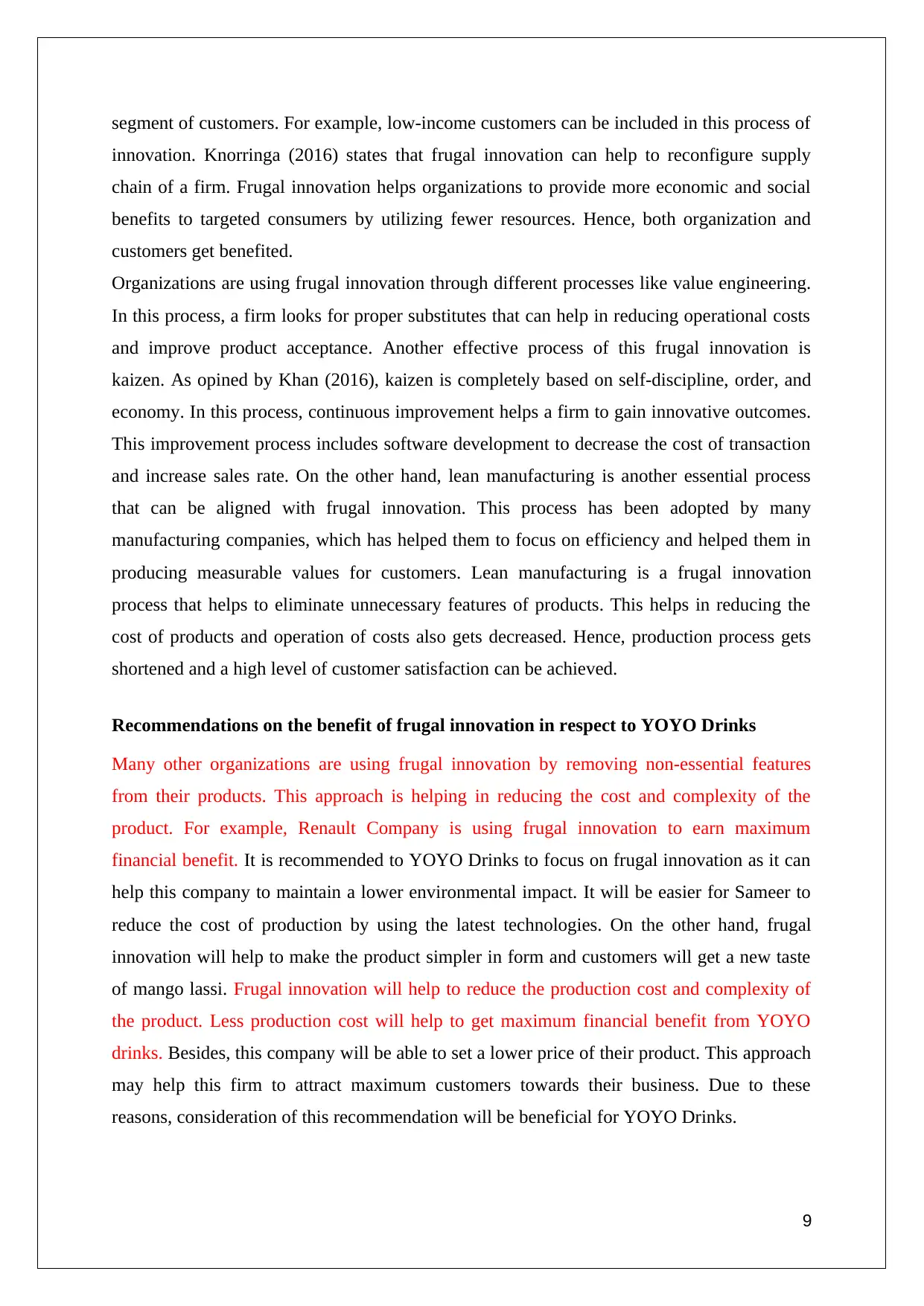
segment of customers. For example, low-income customers can be included in this process of
innovation. Knorringa (2016) states that frugal innovation can help to reconfigure supply
chain of a firm. Frugal innovation helps organizations to provide more economic and social
benefits to targeted consumers by utilizing fewer resources. Hence, both organization and
customers get benefited.
Organizations are using frugal innovation through different processes like value engineering.
In this process, a firm looks for proper substitutes that can help in reducing operational costs
and improve product acceptance. Another effective process of this frugal innovation is
kaizen. As opined by Khan (2016), kaizen is completely based on self-discipline, order, and
economy. In this process, continuous improvement helps a firm to gain innovative outcomes.
This improvement process includes software development to decrease the cost of transaction
and increase sales rate. On the other hand, lean manufacturing is another essential process
that can be aligned with frugal innovation. This process has been adopted by many
manufacturing companies, which has helped them to focus on efficiency and helped them in
producing measurable values for customers. Lean manufacturing is a frugal innovation
process that helps to eliminate unnecessary features of products. This helps in reducing the
cost of products and operation of costs also gets decreased. Hence, production process gets
shortened and a high level of customer satisfaction can be achieved.
Recommendations on the benefit of frugal innovation in respect to YOYO Drinks
Many other organizations are using frugal innovation by removing non-essential features
from their products. This approach is helping in reducing the cost and complexity of the
product. For example, Renault Company is using frugal innovation to earn maximum
financial benefit. It is recommended to YOYO Drinks to focus on frugal innovation as it can
help this company to maintain a lower environmental impact. It will be easier for Sameer to
reduce the cost of production by using the latest technologies. On the other hand, frugal
innovation will help to make the product simpler in form and customers will get a new taste
of mango lassi. Frugal innovation will help to reduce the production cost and complexity of
the product. Less production cost will help to get maximum financial benefit from YOYO
drinks. Besides, this company will be able to set a lower price of their product. This approach
may help this firm to attract maximum customers towards their business. Due to these
reasons, consideration of this recommendation will be beneficial for YOYO Drinks.
9
innovation. Knorringa (2016) states that frugal innovation can help to reconfigure supply
chain of a firm. Frugal innovation helps organizations to provide more economic and social
benefits to targeted consumers by utilizing fewer resources. Hence, both organization and
customers get benefited.
Organizations are using frugal innovation through different processes like value engineering.
In this process, a firm looks for proper substitutes that can help in reducing operational costs
and improve product acceptance. Another effective process of this frugal innovation is
kaizen. As opined by Khan (2016), kaizen is completely based on self-discipline, order, and
economy. In this process, continuous improvement helps a firm to gain innovative outcomes.
This improvement process includes software development to decrease the cost of transaction
and increase sales rate. On the other hand, lean manufacturing is another essential process
that can be aligned with frugal innovation. This process has been adopted by many
manufacturing companies, which has helped them to focus on efficiency and helped them in
producing measurable values for customers. Lean manufacturing is a frugal innovation
process that helps to eliminate unnecessary features of products. This helps in reducing the
cost of products and operation of costs also gets decreased. Hence, production process gets
shortened and a high level of customer satisfaction can be achieved.
Recommendations on the benefit of frugal innovation in respect to YOYO Drinks
Many other organizations are using frugal innovation by removing non-essential features
from their products. This approach is helping in reducing the cost and complexity of the
product. For example, Renault Company is using frugal innovation to earn maximum
financial benefit. It is recommended to YOYO Drinks to focus on frugal innovation as it can
help this company to maintain a lower environmental impact. It will be easier for Sameer to
reduce the cost of production by using the latest technologies. On the other hand, frugal
innovation will help to make the product simpler in form and customers will get a new taste
of mango lassi. Frugal innovation will help to reduce the production cost and complexity of
the product. Less production cost will help to get maximum financial benefit from YOYO
drinks. Besides, this company will be able to set a lower price of their product. This approach
may help this firm to attract maximum customers towards their business. Due to these
reasons, consideration of this recommendation will be beneficial for YOYO Drinks.
9
⊘ This is a preview!⊘
Do you want full access?
Subscribe today to unlock all pages.

Trusted by 1+ million students worldwide
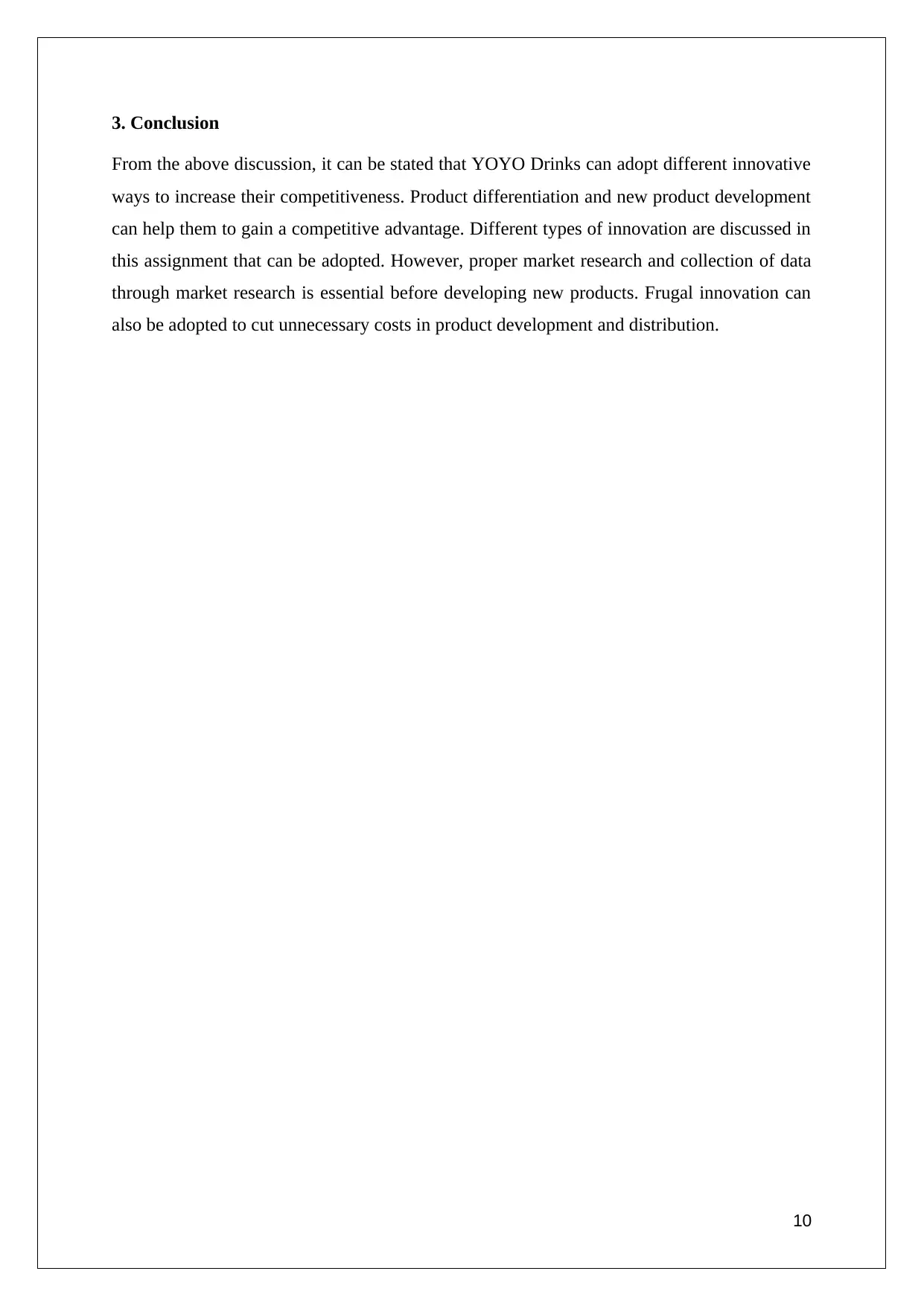
3. Conclusion
From the above discussion, it can be stated that YOYO Drinks can adopt different innovative
ways to increase their competitiveness. Product differentiation and new product development
can help them to gain a competitive advantage. Different types of innovation are discussed in
this assignment that can be adopted. However, proper market research and collection of data
through market research is essential before developing new products. Frugal innovation can
also be adopted to cut unnecessary costs in product development and distribution.
10
From the above discussion, it can be stated that YOYO Drinks can adopt different innovative
ways to increase their competitiveness. Product differentiation and new product development
can help them to gain a competitive advantage. Different types of innovation are discussed in
this assignment that can be adopted. However, proper market research and collection of data
through market research is essential before developing new products. Frugal innovation can
also be adopted to cut unnecessary costs in product development and distribution.
10
Paraphrase This Document
Need a fresh take? Get an instant paraphrase of this document with our AI Paraphraser
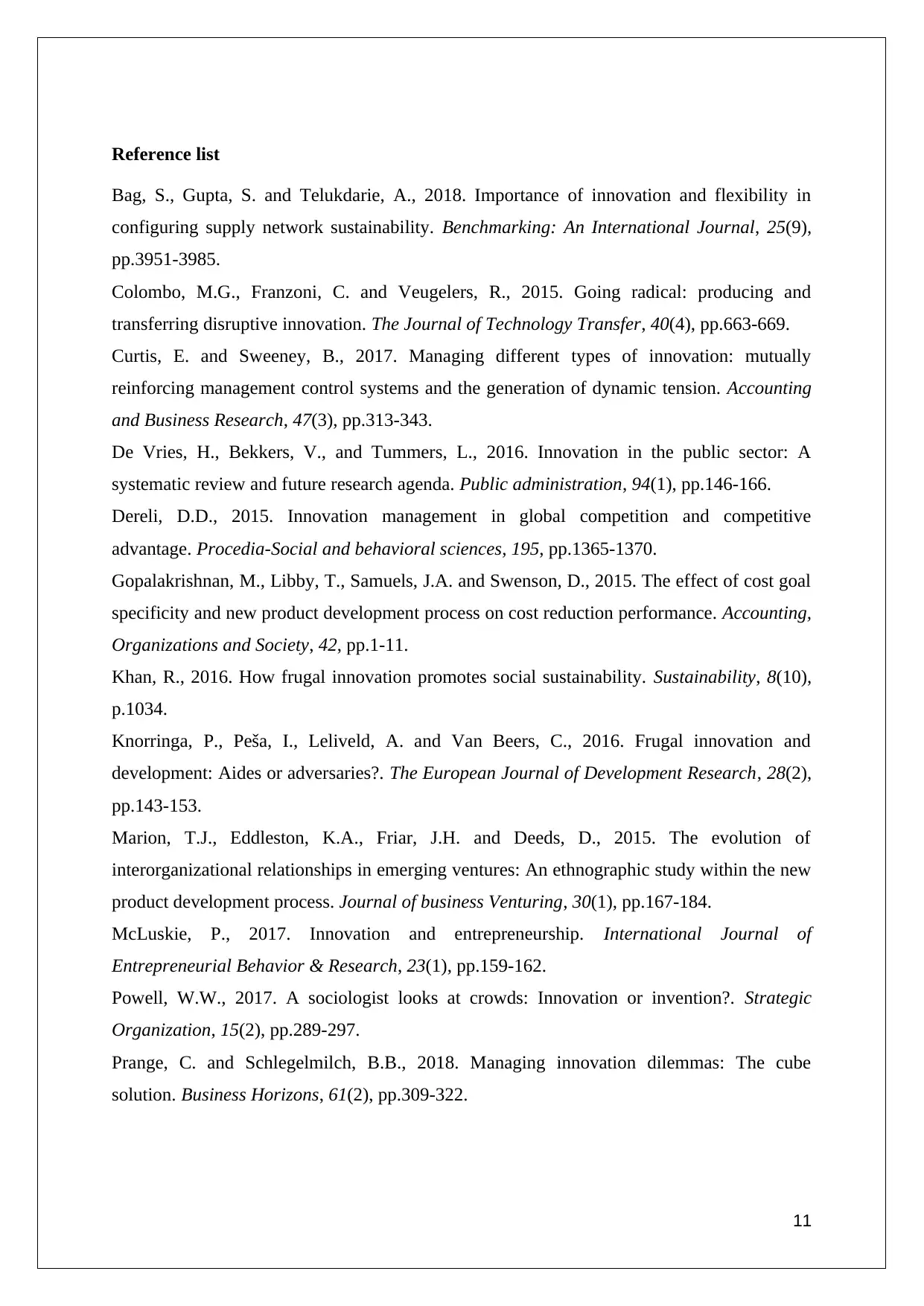
Reference list
Bag, S., Gupta, S. and Telukdarie, A., 2018. Importance of innovation and flexibility in
configuring supply network sustainability. Benchmarking: An International Journal, 25(9),
pp.3951-3985.
Colombo, M.G., Franzoni, C. and Veugelers, R., 2015. Going radical: producing and
transferring disruptive innovation. The Journal of Technology Transfer, 40(4), pp.663-669.
Curtis, E. and Sweeney, B., 2017. Managing different types of innovation: mutually
reinforcing management control systems and the generation of dynamic tension. Accounting
and Business Research, 47(3), pp.313-343.
De Vries, H., Bekkers, V., and Tummers, L., 2016. Innovation in the public sector: A
systematic review and future research agenda. Public administration, 94(1), pp.146-166.
Dereli, D.D., 2015. Innovation management in global competition and competitive
advantage. Procedia-Social and behavioral sciences, 195, pp.1365-1370.
Gopalakrishnan, M., Libby, T., Samuels, J.A. and Swenson, D., 2015. The effect of cost goal
specificity and new product development process on cost reduction performance. Accounting,
Organizations and Society, 42, pp.1-11.
Khan, R., 2016. How frugal innovation promotes social sustainability. Sustainability, 8(10),
p.1034.
Knorringa, P., Peša, I., Leliveld, A. and Van Beers, C., 2016. Frugal innovation and
development: Aides or adversaries?. The European Journal of Development Research, 28(2),
pp.143-153.
Marion, T.J., Eddleston, K.A., Friar, J.H. and Deeds, D., 2015. The evolution of
interorganizational relationships in emerging ventures: An ethnographic study within the new
product development process. Journal of business Venturing, 30(1), pp.167-184.
McLuskie, P., 2017. Innovation and entrepreneurship. International Journal of
Entrepreneurial Behavior & Research, 23(1), pp.159-162.
Powell, W.W., 2017. A sociologist looks at crowds: Innovation or invention?. Strategic
Organization, 15(2), pp.289-297.
Prange, C. and Schlegelmilch, B.B., 2018. Managing innovation dilemmas: The cube
solution. Business Horizons, 61(2), pp.309-322.
11
Bag, S., Gupta, S. and Telukdarie, A., 2018. Importance of innovation and flexibility in
configuring supply network sustainability. Benchmarking: An International Journal, 25(9),
pp.3951-3985.
Colombo, M.G., Franzoni, C. and Veugelers, R., 2015. Going radical: producing and
transferring disruptive innovation. The Journal of Technology Transfer, 40(4), pp.663-669.
Curtis, E. and Sweeney, B., 2017. Managing different types of innovation: mutually
reinforcing management control systems and the generation of dynamic tension. Accounting
and Business Research, 47(3), pp.313-343.
De Vries, H., Bekkers, V., and Tummers, L., 2016. Innovation in the public sector: A
systematic review and future research agenda. Public administration, 94(1), pp.146-166.
Dereli, D.D., 2015. Innovation management in global competition and competitive
advantage. Procedia-Social and behavioral sciences, 195, pp.1365-1370.
Gopalakrishnan, M., Libby, T., Samuels, J.A. and Swenson, D., 2015. The effect of cost goal
specificity and new product development process on cost reduction performance. Accounting,
Organizations and Society, 42, pp.1-11.
Khan, R., 2016. How frugal innovation promotes social sustainability. Sustainability, 8(10),
p.1034.
Knorringa, P., Peša, I., Leliveld, A. and Van Beers, C., 2016. Frugal innovation and
development: Aides or adversaries?. The European Journal of Development Research, 28(2),
pp.143-153.
Marion, T.J., Eddleston, K.A., Friar, J.H. and Deeds, D., 2015. The evolution of
interorganizational relationships in emerging ventures: An ethnographic study within the new
product development process. Journal of business Venturing, 30(1), pp.167-184.
McLuskie, P., 2017. Innovation and entrepreneurship. International Journal of
Entrepreneurial Behavior & Research, 23(1), pp.159-162.
Powell, W.W., 2017. A sociologist looks at crowds: Innovation or invention?. Strategic
Organization, 15(2), pp.289-297.
Prange, C. and Schlegelmilch, B.B., 2018. Managing innovation dilemmas: The cube
solution. Business Horizons, 61(2), pp.309-322.
11
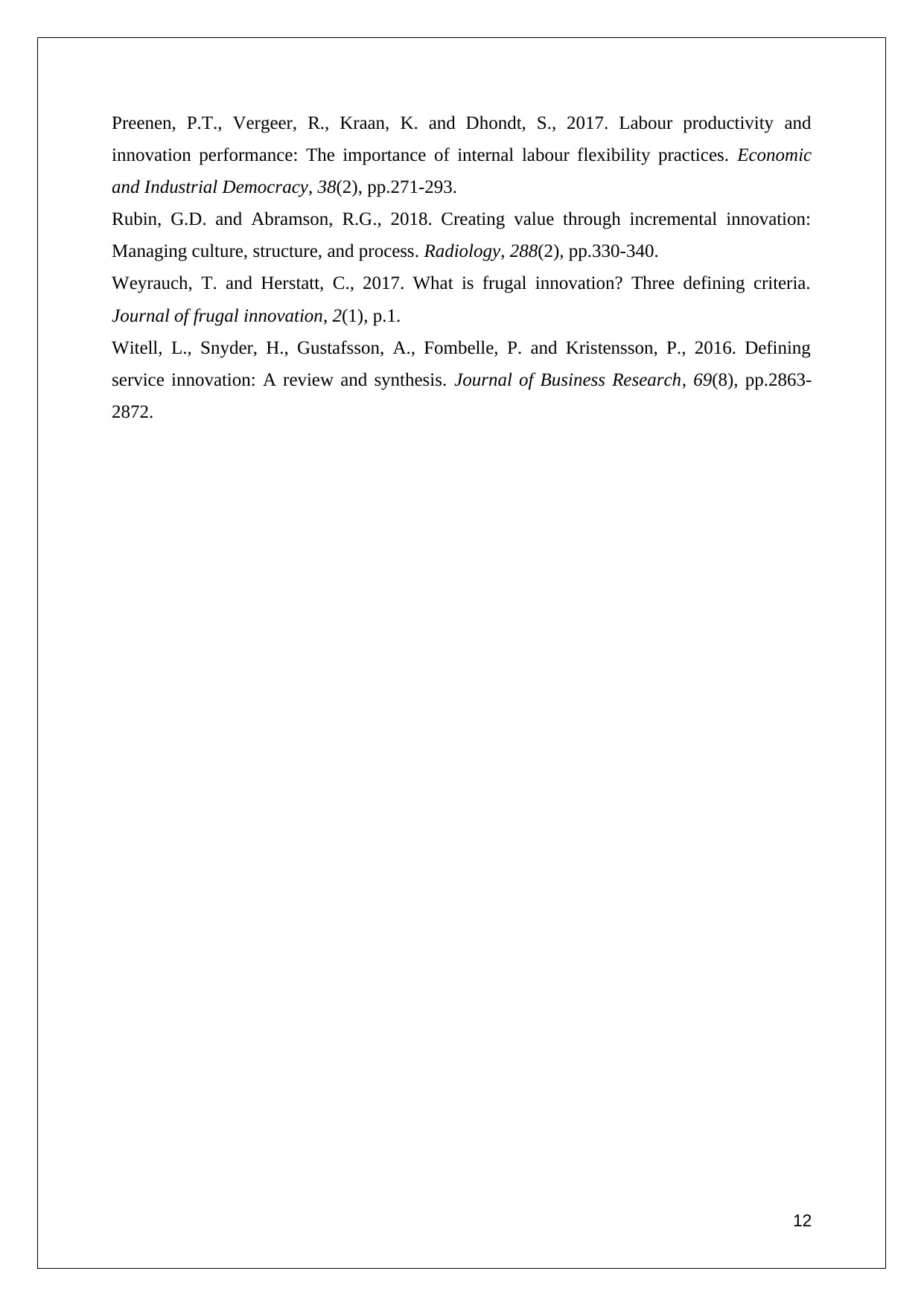
Preenen, P.T., Vergeer, R., Kraan, K. and Dhondt, S., 2017. Labour productivity and
innovation performance: The importance of internal labour flexibility practices. Economic
and Industrial Democracy, 38(2), pp.271-293.
Rubin, G.D. and Abramson, R.G., 2018. Creating value through incremental innovation:
Managing culture, structure, and process. Radiology, 288(2), pp.330-340.
Weyrauch, T. and Herstatt, C., 2017. What is frugal innovation? Three defining criteria.
Journal of frugal innovation, 2(1), p.1.
Witell, L., Snyder, H., Gustafsson, A., Fombelle, P. and Kristensson, P., 2016. Defining
service innovation: A review and synthesis. Journal of Business Research, 69(8), pp.2863-
2872.
12
innovation performance: The importance of internal labour flexibility practices. Economic
and Industrial Democracy, 38(2), pp.271-293.
Rubin, G.D. and Abramson, R.G., 2018. Creating value through incremental innovation:
Managing culture, structure, and process. Radiology, 288(2), pp.330-340.
Weyrauch, T. and Herstatt, C., 2017. What is frugal innovation? Three defining criteria.
Journal of frugal innovation, 2(1), p.1.
Witell, L., Snyder, H., Gustafsson, A., Fombelle, P. and Kristensson, P., 2016. Defining
service innovation: A review and synthesis. Journal of Business Research, 69(8), pp.2863-
2872.
12
⊘ This is a preview!⊘
Do you want full access?
Subscribe today to unlock all pages.

Trusted by 1+ million students worldwide
1 out of 12
Related Documents
Your All-in-One AI-Powered Toolkit for Academic Success.
+13062052269
info@desklib.com
Available 24*7 on WhatsApp / Email
![[object Object]](/_next/static/media/star-bottom.7253800d.svg)
Unlock your academic potential
Copyright © 2020–2025 A2Z Services. All Rights Reserved. Developed and managed by ZUCOL.



